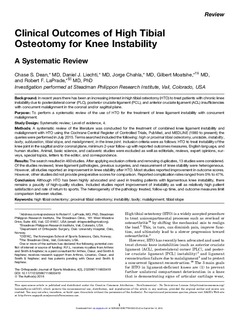| dc.description.abstract | Background: In recent years there has been an increasing interest in high tibial osteotomy (HTO) to treat patients with chronic knee instability due to posterolateral corner (PLC), posterior cruciate ligament (PCL), and anterior cruciate ligament (ACL) insufficiencies with concurrent malalignment in the coronal and/or sagittal plane.
Purpose: To perform a systematic review of the use of HTO for the treatment of knee ligament instability with concurrent malalignment.
Study Design: Systematic review; Level of evidence, 4.
Methods: A systematic review of the literature was conducted for the treatment of combined knee ligament instability and malalignment with HTO using the Cochrane Central Register of Controlled Trials, PubMed, and MEDLINE (1980 to present); the queries were performed in July 2015. Terms searched included the following: high or proximal tibial osteotomy, unstable, instability, laxity, subluxation, tibial slope, and malalignment, in the knee joint. Inclusion criteria were as follows: HTO to treat instability of the knee joint in the sagittal and/or coronal plane, minimum 2-year follow-up with reported outcomes measures, English language, and human studies. Animal, basic science, and cadaveric studies were excluded as well as editorials, reviews, expert opinions, surveys, special topics, letters to the editor, and correspondence.
Results: The search resulted in 460 studies. After applying exclusion criteria and removing duplicates, 13 studies were considered. Of the studies reviewed, knee ligament pathologies, previous surgeries, and measurement of knee stability were heterogeneous. However, all studies reported an improvement in knee stability after HTO. Most studies reported improvement in outcome scores. However, other studies did not provide preoperative scores for comparison. Reported complication rates ranged from 0% to 47%.
Conclusion: Although HTO has been highly advocated and used in treating patients with ligamentous knee instability, there remains a paucity of high-quality studies. Included studies report improvement of instability as well as relatively high patient satisfaction and rate of return to sports. The heterogeneity of the pathology treated, follow-up time, and outcome measures limit comparison between studies. | nb_NO |
